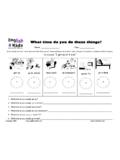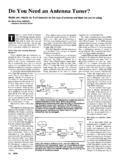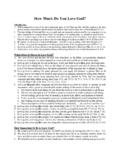Transcription of How many PIXELS do you need? - theimage
1 How many PIXELS do you need? by ron gibbsWe continue to move forward into the age of digital photography. The basicbuilding block of digital images is the pixel which is the shorthand for picture element. The pixel is one unique unit of an image. It is the smallest piece thatcan be changed or edited in a digital are two kinds of graphics in the computer world, pixel based images, andvector based images. Vector images actually use math equations to defineportion of an image, and other design characteristics. A circle can be defined asa group of points located at a fixed distance from a shared center. Sounds toughdoesn t it? It s not, and the advantage comes from the way a circle is it is an equation, you can double the size or half the size or change it byany fractional value without any loss in the way it advantage of vector graphics is their flexibility in changing size without anyloss in their quality.
2 Fine editing and very small control is not a strong point ofvector graphics, they are not as flexible when you wish to change a small pieceof the original. They are not good when it comes to describing very complex colorgradients or finely detailed interior patterns as the math becomes too based graphics are made up of small individual pieces of the whole, andeach can be changed via editing. Their strength is in creating complex patternsand displaying photographs with many color changes. Their weakness is inchanging size. pixel images can be reduced in size, but lose quality when theyare increased in cameras and scanners (both film and paper type) capture information inthe pixel format. Software like iPhoto, Photoshop, Elements, and other paint style packages are pixel editors.
3 When you purchase that new camera orscanner one of the specifications is resolution. Notice resolution is measured inpixels! (Or sometimes dpi dots per inch )The way of presenting PIXELS differs in cameras and scanners. The final result isthe same, but the nomenclature is different. So we want to know how manypixels are needed to .. hum .. that is the question isn t it? Before you can definehow many PIXELS are needed we have to answer a related question .. what willyou do with the image? The number of desired PIXELS and their groupings varywith the final resolution is based on two factors, the total number of PIXELS , and thenumber of PIXELS per unit value. Since an image is made up of individual pictureelements, it can be thought of as a grid (or array) of individual elements.
4 Imageresolution is often given as two numbers representing the total number of pixelsin each the x and the y total number of PIXELS defines the detail level that can be displayed orcaptured in an image. The DPI (density of PIXELS ) is adjusted depending upon thefinal use of the image. For now accept the fact that for WEB use or display on amonitor 75 DPI is sufficient. For use with a printer (inkjet or laser) you will need150-300 DPI. Well discuss this later and explain why each is diagram below depicts a very simple image that just happens to be 1 inch ona side. It is a blue circle in a gray square. If I were to buy a camera with 4 pixel (not Mega- pixel ) resolution, then the image would be divided into a 2 by 2 grid,and each pixel (individual element) would be sampled for a single (averagecolor).
5 If I had a 4 by 4 camera it would have 16 total pixel of resolution, and thesame process would apply. An 8 by 8 camera would have 64 pixel resolution andagain each pixel would be averaged for a single top row represents the divisions that are used for camera sampling, themiddle row shows the grid with the averaged colors for each pixel , and the finalrow shows the resultant digital image. The shape actually begins to appear in the8 by 8 pixel image. More resolution (more PIXELS ) will produce more detail in thedigital image. More is better for image still use some video based technology so they capture images at about72-75 DPI (dots per inch). We will discuss this more when we look at scannersand printing. When you buy a digital camera they are advertised as 1 megapixel,2 megapixel, 3 megapixel, and even up to about 6 megapixel.
6 This translates to1, 2, 3, or up to 6 million PIXELS of data. The following table shows some typical x y values for the PixelsTypical pixel RatioActual Resolution1 mega pixel1024x768, 1280x960(768 Kp, Mp)2 mega pixel1600x1200, 1704x1257( Mp, Mp)3 mega pixel2048x1536, 2140x1560( Mp, Mp)4 mega pixel2272x1704, 2408x1758( Mp, Mp)5 mega pixel2560x1920, 2592x1944( Mp, Mp)6 mega pixel3008x2000, 3024x2016( Mp, MP)For any given image the more PIXELS you apply, the more detail will be question is; How many PIXELS do you really need? There is no single answerto the question, it is dependent upon the use you put the image. Remembercamera technology captures images at 75 dpi so we can create a second tableshowing the size of the images captured in the camera displayed at 75 dpi andredefined as150 dpi (potential dpi for print).
7 pixel SizeImage on CRTI mage Size for Print1280 x 960 (1 MP)17 x @ x @ 150 dpi1600 x 1200 (2 MP) x 16 @ x 8 @ 150 dpi2048 x 1536 (3 MP) x @ x @ 150 dpi2272 x 1704 (4 MP) x @ x @ 150 dpi2560 x 1920 (5 MP) x @ x @ 150 dpi3008 x 2000 (6 MP) x @ 75dpi20 x @ 150 dpiThe first column displays the actual pixel size captured by the camera. It is thesame total number of PIXELS as that described in column 2 and 3. The nextcolumn is simply the pixel dimensions divided by 75 dpi. Besides being thenormal resolution captured by a camera, 75 dpi is the normal display resolutionfor most CRT screens. Hence there is a one to one correlation with the 75 dpiimage and the size it will be displayed on a monitor or CRT now take it on faith that to create an image for print, it is necessary to resetthe dpi to between 150-300 for most printers.
8 Here is the first really importantpoint to understand, changing from 75 dpi to 150 dpi or to 300 dpi does not haveany effect on the image. It is simply a bookkeeping job for the example look at the 2 Mp image (1600 x 1200 @ 75 dpi), this is exactly thesame as 1600 x 1200 @ 150 dpi, or 1600 x 1200 @ 300 dpi. The size of theimage in inches (its print size) will change, but the overall resolution remains thesame 1600 x 1200. If the total number of PIXELS remains the same, then there isno change in the resolution. The table shows that at 1600 x 1200 the 75 dpiimage will be x 16 or it will be x 8 at 150 has a Resize dialog that provides a means to change virtually any ofthe related data. The dialog is shown below.
9 The top of the dialog (A) shows theactual resolution of the image. The bottom input box (C) show the current chains on the right side (red boxes) simply illustrate that the two chainednumbers will maintain the same ratio during a change. Hence if you halve the1600 in the top (A) box to a value of 800, then the second box will be halved alsofrom 1200 to 600 here is the interesting thing, the (C) DPI dialog box is directly connected tothe overall resolution of the image. If you change it from 75 dpi to 150 dpi theoverall resolution reacts at the same time. It changes from 1600 to 3200. Noticehowever that the size indicated in inches (B) does not change when the DPI ismodified. This whole dialog box is designed and based on print use.
10 It maintainsthe same size print when the dpi is changed and it does this by changing theoverall resolution. Frankly this is not you change the DPI value to a higher value, then the overall resolutionincreases. Unfortunately this happens by a process called averaging original image PIXELS and inserting them creates thenew PIXELS that increase the overall resolution. The result is an overall softening(blurring) of the image. Additional PIXELS that are creating by interpolation are notdesirable since they contain no real (valid) you increase the dpi value (Path 2 in example above), it automaticallycauses an increase in the overall number of PIXELS , and it generates newinformation by pixel averaging. This maintains the print size (Document Size), butat the cost of image degradation.







